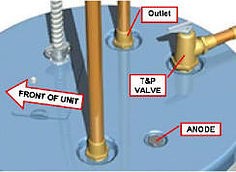 Did you know that we can help you extend the life of your water heater by up to 10 years, perhaps even longer? Looked at another way, you can effectively double its expected lifespan since a water heater’s average time on this earth is 10 – 12 years.
Did you know that we can help you extend the life of your water heater by up to 10 years, perhaps even longer? Looked at another way, you can effectively double its expected lifespan since a water heater’s average time on this earth is 10 – 12 years.
How? Actually, in a few different ways, but it all starts with an annual performance and safety inspection. That allows us to check for signs of visual wear, water leaks, gas and carbon monoxide leaks, and to take other steps critical to your system’s smooth performance and your family’s added safety.
But there are two additional steps that are every bit as important to your water heater’s longevity:
- • Replace the sacrificial anode rod every 4-5 years
- • Flush out all of the minerals and sediment inside the storage tank every 3 – 5 years
The anode rod is made of steel, is connected to the top of your storage tank, and protrudes down into the tank itself. What’s more, the word “sacrificial” is part of its name for a very good reason: this steel-made rod is designed to attract internal minerals, rust, and other particles so it can protect the inside lining walls of the tank. In short, the anode rod is designed to take one for the team, and it does its job very, very well. Well, at least for a good 4-5 years. Hence the need to have it replaced at regular intervals.
Is it time to replace your anode rod? The answer is probably “yes” if your hot water is rust-colored or if you can hear banging inside the systems’ storage tank. That likely means the anode is so rusted that it’s actually broken off from its cap and is bouncing around inside the tank as water passes through it. Left alone long enough, that can greatly shorter you’re your system lifespan.
At Burton, we’re here to help protect your investment in a steady and safe supply of hot water. That’s why we urge you to call today for service if it’s been a year or longer since your last performance and safety inspection.






